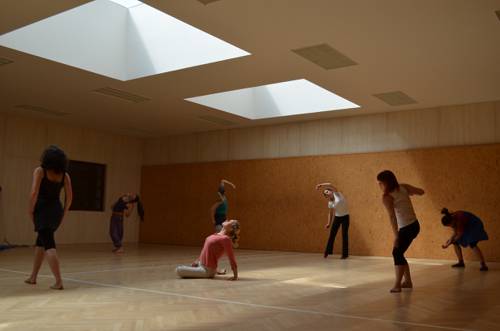
FAQ About The Role of Dance Therapy in Emotional Well-being

What is dance therapy and how does it work?
Dance therapy, also known as dance movement therapy (DMT), is a form of expressive therapy that uses movement and dance to support physical, emotional, and mental well-being. It works by engaging individuals in creative movement, helping them express emotions and experiences that may be difficult to articulate verbally. This process can promote emotional release, enhance self-awareness, and facilitate personal growth.

What are the benefits of dance therapy for emotional well-being?
Dance therapy can offer numerous benefits for emotional well-being, including reducing stress and anxiety, improving mood, boosting self-esteem, and enhancing body awareness. By facilitating non-verbal expression, it allows individuals to explore and process emotions in a safe and supportive environment, which can lead to increased self-acceptance and emotional resilience.

Who can benefit from dance therapy?
Dance therapy can be beneficial to a wide range of individuals, including children, adolescents, adults, and the elderly. It is particularly useful for people experiencing emotional difficulties, stress, anxiety, depression, trauma, or chronic illness. Additionally, it can support those seeking personal growth, improved self-expression, and enhanced emotional regulation.

How is dance therapy different from regular dancing?
While regular dancing often focuses on learning steps, routines, or recreational enjoyment, dance therapy prioritizes self-expression and personal insight through movement. Facilitated by trained therapists, sessions are tailored to address emotional and psychological needs rather than simply focusing on dance technique or performance.

What qualifications do dance therapists need?
Dance therapists typically require specialized training in dance therapy from accredited programs. This includes a deep understanding of psychology and dance/movement. Certifications and licenses vary by country, but many professionals are registered with organizations such as the American Dance Therapy Association (ADTA) or the UK Council for Psychotherapy (UKCP).

How can dance therapy help with anxiety?
Dance therapy can help alleviate anxiety by providing a physical outlet for stress and tension. Through rhythmic movement and embodied awareness, individuals can explore and release pent-up emotions, leading to a calming effect. Structured and guided sessions enable participants to gain a better understanding of their bodily sensations and emotional states, fostering relaxation and emotional release.

Is dance therapy effective for children?
Yes, dance therapy can be highly effective for children. It can aid in emotional expression, enhance social skills, and build confidence. Since children often communicate and process emotions through play and movement, dance therapy provides a natural and engaging medium for them to explore their feelings and improve their emotional intelligence.

What should I expect in a dance therapy session?
A typical dance therapy session begins with a warm-up to help participants become attuned to their bodies. This is followed by guided or improvisational movement exercises designed to explore emotions and themes relevant to the individual. Sessions often conclude with a cooldown period, providing a space for reflection and integration of the experience. The structure can vary based on personal goals and therapist guidance.

How often are dance therapy sessions recommended?
The frequency of dance therapy sessions can depend on individual needs and therapeutic goals. Some may benefit from weekly sessions, while others might find more intensive programs useful. Typically, regular sessions over a few months are recommended to achieve meaningful progress in emotional well-being.

Can those with physical disabilities participate in dance therapy?
Yes, individuals with physical disabilities can participate in dance therapy. Therapists adapt movements to accommodate various abilities and ensure everyone can engage in meaningful expression. The focus is on the expressive potential of movement rather than physical capability, making it inclusive for all participants regardless of mobility.

How does dance therapy promote self-expression?
Dance therapy promotes self-expression by offering a non-verbal medium through which individuals can explore and communicate their inner experiences. Movement allows for the expression of emotions that might be challenging to articulate with words, providing an alternative pathway to personal insight and emotional release.

What populations can dance therapy support besides individuals with emotional issues?
Besides individuals with emotional challenges, dance therapy can support those with developmental disorders, learning disabilities, chronic pain, neurological conditions, and trauma survivors. It also benefits anyone seeking personal growth, improved self-awareness, or creative expression.

What evidence supports the effectiveness of dance therapy?
Numerous studies have demonstrated the effectiveness of dance therapy in improving emotional well-being. Clinical research shows significant improvements in areas such as mood enhancement, stress reduction, and increased body image satisfaction. These positive outcomes are supported by evidence indicating changes in brain chemistry and emotional processing.

How does dance therapy enhance mood and emotional balance?
Dance therapy enhances mood and emotional balance by encouraging physical activity, which naturally boosts endorphins, the body's feel-good hormones. Additionally, the process of creative expression and emotional release within a therapeutic setting helps regulate emotions and allows for a greater sense of emotional stability and contentment.

Are there different types of dance therapy techniques?
Yes, there are various techniques used in dance therapy, including authentic movement, creative movement therapy, and developmental movement therapy. These techniques vary in focus and methodology, ranging from improvisational exploration to structured movements tailored to developmental needs. Each technique is selected based on the individual's unique therapeutic goals.

Can dance therapy help improve self-confidence?
Dance therapy can significantly improve self-confidence by promoting positive body awareness and acceptance. Engaging in expressive movement can help participants feel more comfortable with their bodies and how they express themselves, leading to improved self-image and increased confidence in social interactions and personal endeavors.

How is dance therapy integrated into mental health treatment plans?
Dance therapy can be integrated into holistic mental health treatment plans alongside other therapies such as cognitive behavioral therapy (CBT), psychotherapy, or medication management. It provides a complementary approach that enhances the overall treatment by addressing emotional expression and somatic experiences that might not be fully accessed through traditional talk therapies.

What is the history of dance therapy?
Dance therapy has roots in early 20th-century dance and psychology. It gained formal recognition as a therapeutic practice in the mid-20th century, largely thanks to pioneers such as Marian Chace and Isadora Duncan, who explored the connection between movement and emotional expression. Today, dance therapy continues to evolve, drawing from diverse fields of psychology, kinesiology, and the arts.

Can dance therapy be done in a group setting?
Yes, dance therapy can be conducted in both individual and group settings. Group sessions offer unique benefits, such as building community, enhancing social skills, and fostering a sense of shared experience and support. Participants can learn from each other's movements and experiences, further enriching the therapeutic process.

What should I wear to a dance therapy session?
It is recommended to wear comfortable clothing that allows for free movement during dance therapy sessions. Clothes should not restrict movement and should accommodate various dance positions and activities. Participants might also consider wearing layers to adjust for temperature changes during the session.
